VIEWS AND OPINIONS
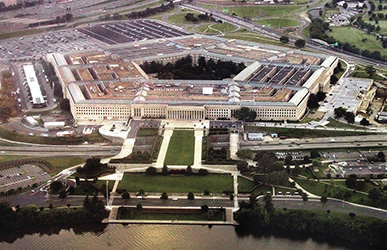
Credit: Reuters RTXKOKQ by Hyungwon Kang
The Pentagon
American Military Justice:When the Enemy Is Too Close
by Pascal Lévesque
For more information on accessing this file, please visit our help page.
Introduction
You have just been sexually assaulted by your supervisor. Deeply shaken, all the more so since he is a ‘brother in arms,’ you gather up your courage and file a complaint at your unit. But they do not believe you. Worse, they imply that you are lying and treat you like a troublemaker. In desperation, you go directly to the military police, who conscientiously take down your statement. However, at the end of the investigation, you are told that what happens next depends upon the decision that the authorities at your parent unit make. But they seem indifferent to your fate. They even try to silence you by threatening you with legal action (malfeasance, false complaint, adultery). Much to your chagrin, the perpetrator is moving on in his career with few-to-no consequences. You are psychologically devastated and struggle with staying in an organization you used to trust where you were destined for a brilliant career. Overwhelmed by dark thoughts, you consider putting an end to it all . . .
In The Invisible War, that scenario is shown as occurring all too frequently in the United States Armed Forces. The documentary film, written and directed by Kirby Dick, depicts a disturbing state of affairs through the stories of victims who, according to estimates, are among some 19,000 people who were sexually assaulted (in incidents ranging from sexual touching to rape) in 2010. The film, which was nominated for Best Documentary Feature at the 2013 Oscars,1 shows that in the American military justice system, it is essentially the chain of command that appoints an investigator, decides whether or not to move forward with the case, and, if so, appoints a prosecutor. The filming of the documentary coincided with a class-action lawsuit to change that process. Twenty-five women and three men argued that the U.S. Secretaries of Defense who have served since 2001 have failed to implement legislation adopted by Congress aiming to reduce the high rate of impunity with regard to sexual assault in the armed forces, and that this failure deprives victims of their constitutional right to be protected by the law.2 They are now appealing the decision of the trial judge, who determined that, despite the troubling allegations, it was better not to get involved because matters of military discipline should be left to the political branches that are accountable to the elected officials.3

Credit: DVIDS photo 818599. U.S. Marine Corps photo by Corporal Christina O’Neil
The U.S. Capitol Building in Washington, D.C.
A delicate subject handled thoughtfully
Though he is dealing with a hot topic, the director shows restraint. There is no voiceover making inflammatory statements to provoke the audience’s indignation. Rather, it is the interviewees’ stories that touch the viewer with their authenticity. When a victim looks away from the interviewer to try to recall the tragic events and when, in mid-sentence, the victim is suddenly overcome with emotion, even the most dispassionate of jurists is moved. One might wonder why some victims were given more screen time than others. It could well be that the choice and length of the stories were motivated by cinematographic or legal considerations (some people may not have authorized the use of their full story in the film). In addition, the filmmakers give others a chance to speak: loved ones and retired military members talk about their sense of helplessness in the face of a victim’s suffering and their disbelief at the administration’s decision to close the case despite the overwhelming evidence. On that point, the filmmakers gave representatives from the U.S. Forces chain of command a chance to explain the measures in place to prevent sexual assault and respond to complaints. But at some points, their responses are so clichéd and ambiguous that we are left wondering whether they have deliberately painted themselves into a corner in a media war they have already lost.
An appeal to the American public
Make no mistake—The Invisible War is not a scientific documentary or a legal study that paints a complete picture. Even though the film states ‘right off the bat’ that all of the statistics cited come from the U.S. Department of Defense,4 we may question it when the film informs us that, in cases of suspected sexual assault, only a minuscule number of them will lead to jail time for the perpetrators. That reality is not unique to the American military justice system; in any criminal justice system, there is a bottleneck of reported cases. The analysis would have to be pushed further, and American military justice would have to be compared with civilian justice or similar military justice systems in that respect, in order to explain any disparities. For example, studies should be referenced to support the conclusion that the low number of complaints from victims of sexual assault in the United States Armed Forces can be explained in part by those victims’ shame and fear of reprisal.5
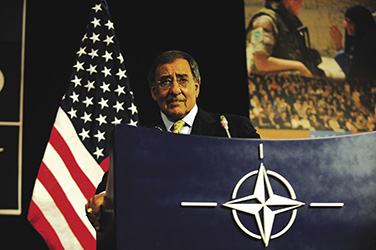
Credit: DVIDS photo 470876, by Technical Sergeant Jacob N. Bailey
Defense Secretary Leon Panetta
Essentially, The Invisible War is an appeal to the American public, and particularly its elected officials, that attempts to convince them of the importance of making major changes to the U.S. military justice system regarding the way allegations of sexual assault are handled. We see numerous meetings between the victims and members of Congress, both Republicans and Democrats. It will be clear to a litigator that it was probably on the advice of their lawyer, Susan Burke, that the victims agreed to bring their stories to the screen. And the strategy seems to have worked—not long after the first public screening of the film in January 2012, the U.S. Secretary of Defense at that time, Leon Panetta, adopted new rules aiming that, for greater transparency, response to complaints of serious sexual assault not be exclusively reserved for commanders, and that commanders be required to report such cases to a special court martial level, normally a colonel.6 To further protect complainants, they are offered the chance to transfer to another unit to distance themselves from the alleged perpetrators.7 The Department of Defense also took measures to standardize and improve the quality of the training for commanders and recruits alike on complaint prevention and response.8 However, according to Nancy Parrish, President of Protect Our Defenders, an American organization that advocates for military victims of sexual assault, the reforms do not go far enough to break the culture of silence in the face of abuse of authority.9 During her testimony before the United States Commission on Civil Rights in January 2013, Ms. Parrish said that she agreed with the idea of an independent audit of sexual assault investigations and trials.10 In response, Major-General Gary Patton, Director of the Department of Defense Sexual Assault Prevention and Response Office, cautioned against measures that would completely remove commanders from the process, given their interest and their expertise in maintaining discipline among their troops.11
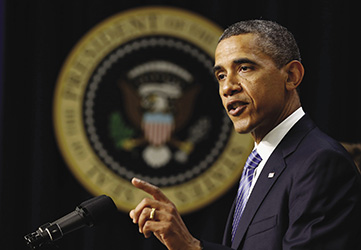
Credit: Reuters RTR361EE by Larry Downing
U.S. President Barack Obama
The Wilkerson case
But before the Commission could make recommendations to President Obama and Congress on how to proceed,12 events intervened. In early March, the news that Lieutenant General Craig Franklin had overturned a guilty verdict reached in Lieutenant Colonel James Wilkerson’s case made headlines in the American media.13 Lieutenant Colonel Wilkerson had been convicted in November 2012 of sexual assault by a court martial made up of five officers.14 The dismissal of the verdict was all the more controversial because Lieutenant General Franklin, who acted as the convening authority, did not give a reason for his decision, although he was not required to under the law.15 In addition, his decision went against the recommendation of his legal advisor.16 Even though Lieutenant General Franklin later defended his decision to Michael Donley, Secretary of the Air Force, nothing worked.17 Faced with what appeared to them as a symptom of a defective system, members of Congress advocating for reform redoubled their efforts. In the momentum generated by the documentary,18 a number of other acts were introduced. The proposed measures include establishing the position of special prosecutor for the victims;19 mandatory release from the forces, at a minimum, for perpetrators of the most serious sexual crimes;20 the creation within the military justice system of a chain of command able to respond more independently to sexual assault complaints;21 and increased prevention measures, particularly banning individuals with previous sexual offence convictions from enrolling.22 Feeling those winds of change, the new Secretary of Defense, Chuck Hagel, in addition to the measures already announced by his Department, decided to limit the convening authority’s power to overturn a court martial verdict to the most minor of cases.23 The new measures also require any commander who modifies a sentence or the verdict for a minor infraction to set out the reasons for that decision in writing.
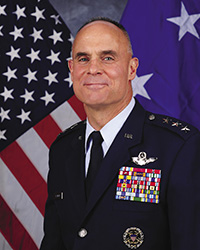
Credit: USAF www.af.mil
Lieutenant General Craig A. Franklin
The situation in Canada
Although it is by no means perfect, the Canadian military justice system is quite different from that of the United States. In response to the tragic incidents that occurred in Somalia in 1994, a series of measures were adopted in order to better prevent incidents and respond to complaints. Those measures include the adoption of legislation in 1998 establishing greater independence and transparency for actors in the military justice system (police officers, prosecutors and judges)—a reform the documentary advocates for the American military justice system. For example, complaints of sexual assault are investigated by the National Investigation Service (NIS). The NIS is authorized to lay charges24 and can, if a commander refuses to take action, bring the case directly to a higher authority, which refers the case to the Director of Military Prosecutions.25 Also, a wide-ranging harassment prevention and resolution program, for all types of harassment, was put in place.26 Moreover, there is a zero tolerance policy for sexual misconduct,27 which leads to an investigation and remedial measures that can include, in the most serious cases, the release of the member at fault.28 In their most recent annual or special reports, neither the Canadian Armed Forces Ombudsman29 nor the Chair of the Military Police Complaints Commission30 identified a systemic issue regarding the way sexual assault complaints are handled. The same goes for the two independent reviews of the National Defence Act conducted by former judges Lamer in 200331 and LeSage in 201132 that focused in particular upon the military justice system.
Should we therefore conclude that in the Canadian military justice system, all is for the best in the best of all possible worlds? Far from it. A single sexual assault will always be one too many. What is more, sexual assault is even harder to bear in a military context because the perpetrator is a brother [or sister] in arms. Not only does that add to the victim’s personal tragedy, it greatly undermines unit cohesion. However, the American situation shows us that the measures adopted by the Canadian Armed Forces about 15 years ago to ensure that complaints are investigated, that legal action is taken and that the accused are judged by military members outside of the chain of command, seem to be the right way forward.
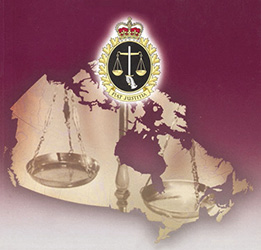
Credit: DND photo
JAG crest superimposed on map of Canada
Lieutenant-Commander Pascal Lévesque, CD, M.A., LL.M., is currently a legal officer at the Canadian Forces Military Law Centre of the Canadian Defence Academy. His duties include teaching the law of armed conflict to officer cadets at the Royal Military College of Canada. During his military career, he has successively served as a unit legal advisor, a litigator and a military justice policy development advisor. His master’s thesis was on the expeditiousness of the court martial system.
Notes
- “Oscars 2013: Complete list of nominees,” in The Los Angeles Times, January 10, 2013, at www.latimes.com/entertainment/envelope/moviesnow/la-et-en-oscars-2013-nomination-list,0,1532667.story (accessed on 23 January 2013).
- Kori Cioca et al. v. Donald Rumsfeld et al., 12-1065, (4th Cir. 2012).
- Kori Cioca et al. v. Donald Rumsfeld et al., 11 cv 151, (Va. E. Dist. Ct. 2011).
- United States Department of Defense, “Sexual Assault Prevention and Response – Annual Reports,” at www.sapr.mil/index.php/annual-reports (accessed on 23 January 2013).
- Olivia Johnson, “Military Sexual Trauma: Shamed into Silence,” 3 Journal of Military Science and Research, Vol. 1 (2012), at www.jghcs.info/index.php/JMSR/article/view/168 (accessed on 23 January 2013).
- United States Department of Defense, comments by Secretary of Defense L. Panetta, 17 April 2012, at www.defense.gov/transcripts/transcript.aspx?transcriptid=5013 (accessed on 23 January 2013).
- Claudette Roulo, “DOD to Revise Sexual Assault Prevention Training,” American Forces Press Service, 25 September 2012, at www.defense.gov/news/newsarticle.aspx?id=118000 (accessed on 23 January 2013).
- United States Department of Defense, News Release No. 774-12, “Department of Defense Expands Sexual Assault Prevention Efforts,” 25 September 2012, at www.defense.gov/releases/release.aspx?releaseid=15585 (accessed on 23 January 2013).
- Nancy Parrish, “Our Military Justice System Needs Fixing,” in The Huffington Post, 17 January 2013, at www.huffingtonpost.com/nancy-parrish/military-justice-women_b_2432537.html (accessed on 23 January 2013).
- Bill Briggs, “Civil Rights Commission urged to order audit of military sex-assault cases,” in NBCNews.com, 11 January 2013, at usnews.nbcnews.com/_news/2013/01/11/16469177-civil-rights-commission-urged-to-order-audit-of-military-sex-assault-cases?lite (accessed on 23 January 2013).
- Ibid.
- Ibid. For more information, consult the Commission website: www.usccr.gov/.
- Evan Pushak, “‘All for nothing’: The military, sexual assault, and the search for justice,” at MSNBC.com, 3 March 2013, at tv.msnbc.com/2013/03/12/all-for-nothing-the-military-sexual-assault-and-the-search-for-justice/ (accessed on 12 May 2013).
- Nancy Montgomery, “Former Aviano IG is found guilty in sexual assault case,” in Stars and Stripes, 2 November 2012, at www.stripes.com/news/former-aviano-ig-is-found-guilty-in-sexual-assault-case-1.195656 (accessed on 12 May 2013).
- Nancy Montgomery, “Case dismissed against Aviano IG convicted of sexual assault,” in Stars and Stripes, 27 February 2013, at www.stripes.com/news/air-force/case-dismissed-against-aviano-ig-convicted-of-sexual-assault-1.209797 (accessed on 12 May 2013). A written statement from the American Air Force said that after careful deliberation, Lieutenant General Franklin had concluded that the entire body of evidence was insufficient to meet the burden of proof beyond a reasonable doubt.
- Nancy Montgomery, “Air Force pilot’s sex assault dismissal sparks cries for reform,” in Stars and Stripes, 3 March 2013, at www.stripes.com/news/air-force-pilot-s-sex-assault-dismissal-sparks-cries-for-reform-1.210371 (accessed on 12 May 2013).
- Craig Withlock, “Air Force general defends overturning sexual-assault conviction,” in The Washington Post, 10 April 2013, at articles.washingtonpost.com/2013-04-10/world/38428317_1_franklin-commanders-conviction (consulted on May 12, 2013); Nancy Montgomery, “Overturning verdict was right decision, general says,” in Stars and Stripes, 12 April 2013, at www.stripes.com/news/overturning-verdict-was-right-decision-general-says-1.216406 (accessed on 12 May 2013).
- Sexual Assault Training Oversight and Prevention Act, H.R. 3435, 112th Cong. (2011).
- Combating Military Sexual Assault Act of 2013 S. 871, 113th Cong. (2013).
- Better Enforcement for Sexual Assault Free Environments Act of 2013, H.R. 1867, 113th Cong. (2013).
- Sexual Assault Training Oversight and Prevention Act, H.R. 1593, 113th Cong. (2013).
- Military Sexual Assault Prevention Act of 2013, S. 548, 113th Cong. (2013).
- United States Department of Defense, News Release No. 218-13, “Statement from Secretary Hagel on Sexual Assault Prevention and Response,” 8 April 2013, at www.defense.gov/releases/release.aspx?releaseid=15917 (accessed on 12 May 2013).
- QR&O 107.02 (c).
- QR&O 107.12 (3).
- DAOD 5012-0 Harassment Prevention and Resolution.
- DAOD 5019-5 Sexual Misconduct and Sexual Disorders.
- DAOD 5019-4 Remedial Measures.
- Canada, National Defence and Canadian Forces Ombudsman, “Reports,” at http://www.ombudsman.forces.gc.ca/rep-rap/index-eng.asp (accessed on 23 January 2013).
- Canada, Military Police Complaints Commission, “Publications – Annual Reports,” at http://www.mpcc-cppm.gc.ca/01/300/300-eng.aspx (accessed on 23 January 2013).
- The Right Honourable Antonio Lamer, The First Independent Review by the Right Honourable Antonio Lamer P.C., C.C., C.D. of the provisions and operation of Bill C-25, An Act to amend the National Defence Act and to make consequential amendments to other Acts, as required under section 96 of Statutes of Canada 1998, c.35, Ottawa, 2003, at http://www.forces.gc.ca/site/reports-rapports/antonio-lamer/index-eng.asp (accessed on 24 January 2013).
- The Honourable Patrick J. LeSage, C.M., O.Ont., Q.C., Report of the Second Independent Review Authority to The Honourable Peter G. MacKay Minister of National Defence, Ottawa, 2011, at http://www.forces.gc.ca/site/reports-rapports/patrick-lesage/index-eng.asp (accessed on 24 January 2013).



